
Duke of Marlborough is a title in the Peerage of England. It was created by Queen Anne in 1702 for John Churchill, 1st Earl of Marlborough (1650–1722), the noted military leader. In historical texts, unqualified use of the title typically refers to the 1st Duke. The name of the dukedom refers to Marlborough in Wiltshire.

Duke of Argyll is a title created in the peerage of Scotland in 1701 and in the peerage of the United Kingdom in 1892. The earls, marquesses, and dukes of Argyll were for several centuries among the most powerful noble families in Scotland. As such, they played a major role in Scottish history throughout the 16th, 17th, and 18th centuries. The Duke of Argyll also holds the hereditary titles of chief of Clan Campbell and Master of the Household of Scotland.

Earl of Selkirk is a title in the Peerage of Scotland, used since 1646. It has rules of inheritance subject to unusual and unique provisions.

Duke of Hamilton is a title in the Peerage of Scotland, created in April 1643. It is the senior dukedom in that peerage, and as such its holder is the premier peer of Scotland, as well as being head of both the House of Hamilton and the House of Douglas. The title, the town of Hamilton in Lanarkshire, and many places around the world are named after members of the Hamilton family. The ducal family's surname, originally "Hamilton", is now "Douglas-Hamilton". Since 1711, the dukedom has been held together with the Dukedom of Brandon in the Peerage of Great Britain, and the dukes since that time have been styled Duke of Hamilton and Brandon, along with several other subsidiary titles.

Duke of Beaufort is a title in the Peerage of England. It was created by Charles II in 1682 for Henry Somerset, 3rd Marquess of Worcester, a descendant of Charles Somerset, 1st Earl of Worcester, legitimised son of Henry Beaufort, 3rd Duke of Somerset, a Lancastrian leader in the Wars of the Roses. The name Beaufort refers to a castle in Champagne, France. It is the only current dukedom to take its name from a place outside the British Isles.

William Douglas-Hamilton, Duke of Hamilton, KG, PC, also known as Lord William Douglas and the Earl of Selkirk, was a Scottish nobleman and politician. He was the eldest son of the 1st Marquess of Douglas by his second wife, Lady Mary Gordon, a daughter of the 1st Marquess of Huntly.

Duke of Fife is a title in the Peerage of the United Kingdom that has been created twice, in both cases for Alexander Duff, 1st Earl of Fife. In 1889, Lord Fife married Princess Louise, the eldest daughter of Albert Edward, Prince of Wales and a granddaughter of Queen Victoria.

Duke of Buccleuch, formerly also spelt Duke of Buccleugh, is a title in the Peerage of Scotland created twice on 20 April 1663, first for James Scott, 1st Duke of Monmouth, and second suo jure for his wife Anne Scott, 4th Countess of Buccleuch. Monmouth, the eldest illegitimate son of King Charles II, was attainted after rebelling against his uncle King James II and VII, but his wife's title was unaffected and passed on to their descendants, who have successively borne the surnames Scott, Montagu-Scott, Montagu Douglas Scott and Scott again. In 1810, the 3rd Duke of Buccleuch inherited the Dukedom of Queensberry, also in the Peerage of Scotland, thus separating that title from the Marquessate of Queensberry.

Duke of Sutherland is a title in the Peerage of the United Kingdom which was created by William IV in 1833 for George Leveson-Gower, 2nd Marquess of Stafford. A series of marriages to heiresses by members of the Leveson-Gower family made the dukes of Sutherland one of the richest landowning families in the United Kingdom. The title remained in the Leveson-Gower family until the death of the 5th Duke of Sutherland in 1963, when it passed to the 5th Earl of Ellesmere from the Egerton family.

Earl of Leicester is a title that has been created seven times. The first title was granted during the 12th century in the Peerage of England. The current title is in the Peerage of the United Kingdom and was created in 1837.

Marquess of Ailsa, of the Isle of Ailsa in the County of Ayr, is a title in the Peerage of the United Kingdom. It was created on 10 September 1831 for Archibald Kennedy, 12th Earl of Cassilis. The title Earl of Cassilis had been created in 1509 for the 3rd Lord Kennedy. This title had been created in the Peerage of Scotland in 1457. The 1st Marquess had been created Baron Ailsa in the Peerage of the United Kingdom on 12 November 1806.

Marquess of Abergavenny in the County of Monmouth, is a title in the Peerage of the United Kingdom created on 14 January 1876, along with the title Earl of Lewes, in the County of Sussex, for the 5th Earl of Abergavenny, a member of the Nevill family.

The Mormaer or Earl of Angus was the ruler of the medieval Scottish province of Angus. The title, in the Peerage of Scotland, is held by the Duke of Hamilton, and is used as a courtesy title for the eldest son of the Duke's eldest son.
Earl of Ruglen was a title in the Peerage of Scotland. Along with the subsidiary titles Viscount of Riccartoun and Lord Hillhouse, it was created on the 14th of April, 1697, for Lord John Douglas-Hamilton, fourth son of William Douglas-Hamilton, Duke of Hamilton, 1st Earl of Selkirk, and his wife Anne Hamilton, 3rd Duchess of Hamilton. The 1st Earl of Ruglen succeeded as 3rd Earl of Selkirk on the death of his elder brother in 1739. The Earl's only son William, Lord Daer, died in 1742, so on the death of the Earl of Selkirk and Ruglen in 1744, the Earldom of Selkirk passed to his great-nephew, while the Earldom of Ruglen passed to his daughter, Anne, who had married William Douglas, 2nd Earl of March. On her death in 1748, the Earldom of Ruglen passed to her only child William, 3rd Earl of March. He succeeded his first cousin once removed Charles Douglas as 5th Marquess and 4th Duke of Queensberry in 1778.

Baron Hamilton of Hameldon, of Hambledon in the County of Leicester, is a title in the Peerage of Great Britain, held by the Duke of Hamilton from 1790 to 1799 and by the Duke of Argyll since 1799.

Anne Hamilton, 3rd Duchess of Hamilton was a Scottish peeress.

Clan Douglas is an ancient clan or noble house from the Scottish Lowlands.

The Clan Hamilton, or House of Hamilton, is a Scottish clan of the Scottish Lowlands.
Lord Basil Hamilton was a Scottish aristocrat who drowned trying to save his servant.

Charles Douglas, 2nd Earl of Selkirk, was a Scottish aristocrat and courtier.
















